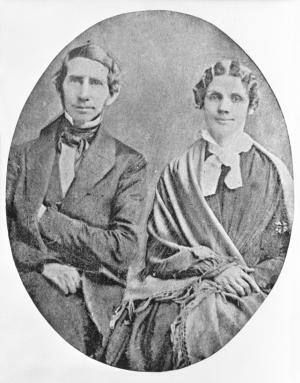 Born in Ohio in 1812, Stephen Riggs was educated at Jefferson College and Western Theological Seminary in Pennsylvania. As a licensed preacher, he was sent by the American Board of Commissioners for Foreign Missions to help Dr. Thomas S. Williamson in his work with the Indians in Minnesota.
Born in Ohio in 1812, Stephen Riggs was educated at Jefferson College and Western Theological Seminary in Pennsylvania. As a licensed preacher, he was sent by the American Board of Commissioners for Foreign Missions to help Dr. Thomas S. Williamson in his work with the Indians in Minnesota.
After spending time at Fort Snelling starting in June of 1837, Riggs and his wife, Mary, spent the summer with the Reverend
Jedediah Stevens at Lake Harriet. They then traveled to Lac qui Parle where for five years they worked among the
Dakota and translated the Bible into the Dakota language with the help of Joseph Renville Sr. He would eventually publish this dictionary with the help of the Minnesota Historical Society and the Smithsonian Institution.
In 1843 Riggs, with the help of Robert Hopkins, opened a Dakota mission at Traverse des Sioux, near modern-day St. Peter, Minnesota. Alexander G. Huggins was assigned to the station in 1846, and Riggs returned to Lac
qui Parle to take the place of Dr. Williamson, who was transferred to work among the Dakota at Kaposia near modern-day South St. Paul, Minnesota.
In 1851, Riggs was one of the interpreters that helped explain terms to the Dakota signers at the Treaty
of Traverse des Sioux. The treaty created changes in the locations of Dakota missions due to the Dakota moving onto reservations in the Southwest part of Minnesota. Dr. Williamson had chosen a new site on the Yellow Medicine River in 1852 which he called Payzhehooteze (the Upper Sioux Agency or Pezuhutazizi), and Riggs joined him there two years later. The Hazelwood mission and republic were then organized by the Riggs party near the Agency as an educational and agricultural center for Christian Dakota.
When the U.S.-Dakota War began, the Hazelwood party came down to the Upper Sioux villages. In the early morning hours of August 19, the Riggs family fled to their Christian Dakota neighbors, who hid them on an island in the Minnesota River, then guided them on their way toward safety that night. Riggs volunteered for service and was made the chaplain to General Sibley's forces. Hazelwood mission was destroyed and when the Dakota were exiled from Minnesota after the war, the missionaries traveled with them where they continued to set up mission stations. Riggs died in Wisconsin in 1883.